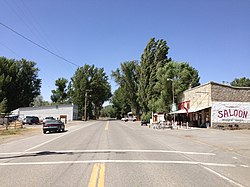Paradise Valley, Nevada
| Paradise Valley, Nevada | |
|---|---|
| Census-designated place | |
 |
|
| Location within the state of Nevada | |
| Coordinates: 41°29′35″N 117°31′59″W / 41.49306°N 117.53306°WCoordinates: 41°29′35″N 117°31′59″W / 41.49306°N 117.53306°W | |
| Country | United States |
| State | Nevada |
| County | Humboldt |
| Area | |
| • Total | 15.9 sq mi (41.3 km2) |
| • Land | 15.9 sq mi (41.3 km2) |
| • Water | 0 sq mi (0 km2) |
| Population (2010) | |
| • Total | 109 |
| • Density | 6.8/sq mi (2.6/km2) |
| Time zone | Pacific (PST) (UTC-8) |
| • Summer (DST) | PDT (UTC-7) |
| ZIP codes | 89426 |
| FIPS code | 32-55400 |
| Reference no. | 89 |
Paradise Valley is a census-designated place (CDP) in Humboldt County, Nevada, United States, near the Santa Rosa Ranger District of Humboldt National Forest. It is located at the northern terminus of Nevada State Route 290, about 19 miles (31 km) northeast of U.S. Highway 95 and a total of 40 miles (64 km) north of Winnemucca. The town is located in a broad valley, with the Santa Rosa Range of mountains just to the northwest. At the 2010 census, the population of the CDP was 109.
As of the census of 2010, there were 109 people, 51 households, and 35 families residing in the CDP. There were 92 housing units. The racial makeup of the CDP was 89.0% White, 1.8% Native American, 6.4% some other race, and 2.8% from two or more races. 18.3% of the population were Hispanic or Latino of any race.
The American Folklife Center of the U.S. Library of Congress conducted extensive ethnographic field research in Paradise Valley from 1978 to 1982. The Paradise Valley Folklife Project generated a multi-format resource collection documenting the history and culture of the area's ranching community. A team of fieldworkers from AFC documented the distinct ethnic groups in the area (Apache, Anglo, Basque, Chinese, German, Italian and Northern Paiute); the history of the region, including archaeological remains of a Chinese community, foodways, and oral traditions. The resulting material was subsequently packaged by the Library of Congress into a collection titled "Buckaroos in Paradise: Ranching Culture in Northern Nevada, 1945-1982". The collection includes 32 boxes of archival material including manuscripts, audio and video recordings, and several thousand photographic prints and negatives from the AFC project and additional historical archives dating back to 1870. The project was initiated by the American Folklife Center in cooperation with the Smithsonian Institution in 1978.
...
Wikipedia

